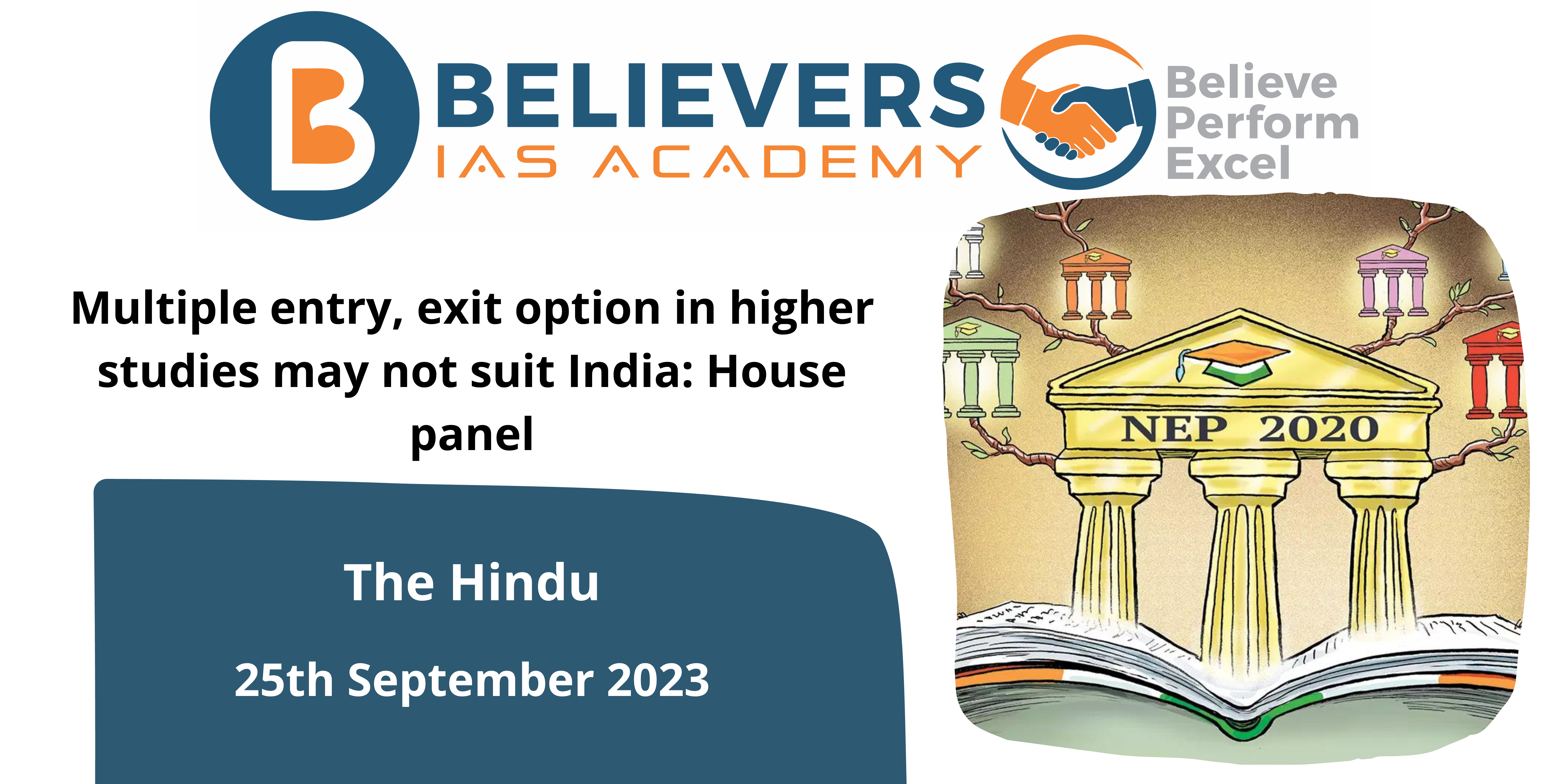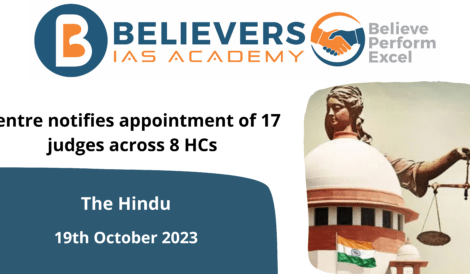Multiple entry, exit option in higher studies may not suit India: House panel
Context:
The National Education Policy (NEP) option for multiple entry and multiple exit (MEME) has drawn criticism from several student and teacher organizations. The BJP MP Vivek Thakur’s Parliamentary Standing Committee on Education has advised the Centre to hold discussions with all stakeholders.
What is the National Educational Policy (NEP)?
- The National Education Policy (NEP) of India 2020 lays out the goals for a new Indian educational system. The goal of the policy is to transform education at every level, from elementary school through college. the following:
- Strengthen teacher training
- Reform the exam system
- Improve early childhood care
- Revise school regulations and governance
- Develop mental skills including critical analysis and problem-solving.
- By 2030, raise the GER from preschool to secondary school to 100%.
- The preceding National Policy on Education, 1986, was replaced by the NEP. The philosophy behind the policy is that social, ethical, and emotional skills should be developed through education.
- The NEP suggests switching from summative to routine and formative evaluation. The NEP further suggests:
- internal assessments until the second grade
- Introducing semesters in Grade 12
- Clearing 8 board exams at the end of Grade 10
- The administration made it clear that the NEP’s language policy is merely a general directive. The National Curriculum Framework will be released in 2021 and will include a more comprehensive language plan.
What is the MEME scheme of the NEP2020?
- The NEP 2020 recommends the adoption of a system that enables students to have several entry and exit points in higher education. This implies that students have the flexibility to start their education in higher education at various phases and to finish it with a degree or certification at various periods.
- Undergraduate degrees should last three or four years, according to NEP requirements. Depending on how many years they finish, students can obtain a certificate, diploma, or degree. Students may graduate with a certificate after one year, a diploma after two years, a bachelor’s degree after three years, or both a bachelor’s degree and research after four years.
What are the concerns raised concerning this scheme?
- Predicting Student Movement is Difficult: Under the MEME system, one of the main worries is the difficulty in predicting how many students will enter and leave the educational system at particular points. Since students might join and leave at any time, it may be difficult for schools to predict their student numbers with accuracy.
- Pupil-teacher ratio disruption: The MEME system may cause problems for the pupil-teacher ratio in educational institutions, according to the report. Unpredictable changes in student enrollment and withdrawal from programs could result in ratio imbalances, which would have an impact on the standard of instruction and the resources allotted to teaching.
- Uneven Geographical Distribution: The uneven geographic distribution of higher education institutions in India has drawn criticism. In remote or inaccessible places, where there may be few educational options available, implementing MEME may be more difficult. According to the article, institutions have not given this problem any thought.
- Lack of Clarity: According to the report, it’s unclear how the MEME system will be efficiently deployed and administered. It implies that institutions might not have specific preparations in place to handle the difficulties MEME will provide when put into operation.
Why isn’t Kerala part of this scheme?
- State Autonomy: Since education is a concurrent issue in India, both the federal government and the states have the power to decide on education-related policy. States are free to adopt or modify federal policies to fit their requirements and goals. Kerala might have decided against implementing MEME because it thinks it has a superior option or because MEME is incompatible with its educational goals.
- Policy Alignment: States may already have their own in place educational policies and procedures. If they feel that their current policies are better suited to their educational objectives and the requirements of their pupils, they may decide to stick with them.
- Challenges and Concerns: Managing the pupil-teacher ratio and anticipating student movement are two challenges and concerns that come with the deployment of MEME. Kerala may have considered these difficulties and determined that, in the context of its particular educational system, the risks exceed the possible rewards.
What are the recommendations of the Parliamentary Standing Committee on Education on MEME?
- Comprehensive Guidelines and Structure: According to the committee, the government should provide thorough guidelines and a clearly defined structure for MEME alternatives in higher education. The implementation and management of MEME should be outlined in detail in these guidelines.
- Specific Eligibility Criteria: The committee recommended that the rules include precise eligibility requirements so that students can enter or leave educational programs at different points. This would make sure that students choose their educational paths with knowledge.
- Mechanisms for Credit Transfer: The committee advised the construction of systems that would let students earn and transfer credits easily between institutions. This will make it easier for students pursuing various educational departure points to transition smoothly.
- Clear Roadmap for Students: For students who opt to explore various exit points from their educational path, the guidelines should also offer a clear roadmap. Students could efficiently arrange their educational pathways with this assistance.
- Credit Accumulation and Transfer (CAT) System Standardization: The committee suggested putting a uniform Credit Accumulation and Transfer (CAT) system in place. Such a system would make it simpler for students to migrate between different educational levels, from certificate courses to Ph.D. degrees, by allowing them to accrue and transfer credits between schools.
Conclusion
To give students more flexibility and choice, MEME refers to the provision of numerous entry and exit options for students in higher education within the context of NEP 2020. However, concerns and difficulties with its execution have been brought up, and the parliamentary committee has suggested more consultations and recommendations to deal with these problems.




